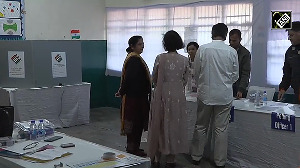In August 1883, the quiet American city of Rochester came tumbling down under a tornado. As 24 people breathed their last, 40 others were left gasping for breath and medical care.
The disaster gave birth to an idea, an idea that became a dream for Dr William Worrall Mayo -- to give Rochester its first hospital.
Six years later, the dream came to life and in September 1889, under the watchful eye of Dr Mayo, Saint Marys Hospital opened its doors to the public. As decades passed, the hospital spilled over into an institution and a research and development centre, giving America and the world one of its largest, most prestigious medical cities -- the Mayo Clinic.
A century after the inception of the clinic, a young Indian doctor practicing in America also began nurturing a dream. He wanted to create in India the same standard of healthcare, training and research that he saw in America, to build in India the Mayo Clinic of the East.
In 2004, almost 20 years after his return from America, popular (and now controversial) heart surgeon Dr Naresh Trehan and president of the Indian Healthcare Federation announced his ambitious project -- the Rs 1,250 crore (Rs 12.50 billion) MediCity coming up in Gurgaon.
Enough ink has already been spilt on Trehan's ignominious exit from the Escorts Heart Institute and Research Centre (EHIRC), but for a huge country like India with healthcare the current buzz, it is hardly surprising that medical and health cities seem to be surfacing on the horizon.
Six months ago the Aditya Birla Memorial Hospital started near Pune, last month Dr Pratap C Reddy swung the doors open to the Apollo Health City in Hyderabad, and at the same time Shivinder M Singh began work on two Fortis Medicities, one in Gurgaon and another in Lucknow, with the promise of eight more in the pipeline.
The concept of a medical or health city stands unprecedented in India. Not surprisingly, it is often a misunderstood term. A cluster of hospitals, a holistic healthcare centre, a large hospital sprawled across acres of land? Certainly.
But it doesn't end here. In simpler terms, the difference between a hospital and a medical city is as vast as the difference between a corner shop and a megastore What you won't find at the shop, you will be certain to get at the store.
In what could be the beginning of a medical renaissance, medical cities could change the way medical education and research and development is conducted in India, taking it from public to private to corporate.
For Trehan, a medical city translates into an institution that has the resources and excellence to take clinical treatment out of operation theatres and into classrooms and laboratories.
"It is an institution of the calibre to train people from the level of a medical school right to the end the highest level of medical education. But this needs to be done through the highest level of faculty, which is not only into practicing medicine but equally involved in teaching and research."
Institutions like the All India Institute of Medical Sciences in Delhi, Christian Medical College in Vellore and Maulana Azad Medical College in Delhi have been pockets of excellence in teaching and research in the country. Until 2005, India had only 229 medical colleges of which 106 were established through the private route with Manipal Hospital in Bangalore towering above the rest for its excellence in research, especially stem cell research.
But despite these institutions, with only 25,000 medical graduates each year, the Indian ratio of doctors to population stands small at 0.6 doctors per 1,000 people, the world average being 1.8 per 1,000. This translates into an immediate need of another 12-13 lakh (Rs 1.2-1.3 million) doctors, a gap so vast it will take decades to fill. A glimmer of hope now flickers in plans that lie atop the tables of medical India's corporate world and within bricks of foundation that have been laid to mark medical city projects.
On top of EHIRC and Fortis Healthcare managing director Shivinder M Singh's office table lie plans for not one but 10 medical cities that will take shape over the next 10 years.
Promising to generate over 10,000 medical graduates each year from each campus and directly generating 30,000 jobs through his medical city projects, Singh is running hard to meet India's requirement for doctors. He too takes inspiration from the Mayo Clinic and the Cleveland Clinic and strives to create a campus that is complete in itself.
"Our medical cities will have an education campus, research facility and multiple disciplines. The intention is to have a multi-super-speciality hospital with expertise in 20 medical disciplines and 8-10 sub-specialties in each. We won't have laboratory research. We will take our research out of the lab and put it to practical application," he explains.
Singh's enormous project coming up in Gurgaon will see an investment of over Rs 1,200 crore (Rs 12 billion) with a 600-800-bed hospital at the education campus alone besides the beds at the multi-super-speciality hospital. In the south, Dr Pratap Reddy's Apollo Hospitals Enterprise Limited took Rs 1,000 crore (Rs 10 billion) out of its pocket to launch the Health City -- a project that marries allopathic medicine with alternative medicine in an attempt to usher in the concept of holistic healthcare under one roof.
Unlike Trehan and Singh's medical city projects that will impart undergraduate and postgraduate medical education, Reddy's educational institution will restrict itself to postgraduate education for doctors under Medical Council of India guidelines.
Dr Hari Prasad, chief executive officer, Apollo Hospitals, says, "We have over 300 students in different courses and our endeavour is to bring together the heavily fragmented healthcare space. At the Health City research and development will happen in a clinical setting allowing both clinical doctors and researchers to interact and take from each other." Having begun operations last month, Reddy is already looking at investing a further Rs 150 crore (Rs 1.50 billion) over the next 18 months to increase the bed count and the doctor count at the Health City.
Interestingly, the turn of the wheel of thought has given birth to a unique concept of research in each mind. Where research at premier institutions like Harvard Medicine, Johns Hopkins and Mayo Clinic continues to redefine medical boundaries, the idea of directly copying therapies, cures and procedures from the West does not go down well with Indians any longer.
"We don't have to copy everything that comes out of the West because their gene pool is different from ours," stresses Trehan, "We must develop our own therapies, our own R&D, our own devices, so that medicine can be custom made for Indians at lower costs."
His own concept is unheard of. At his MediCity, Trehan intends to combine modern medicine, Ayurveda, homeopathy and Chinese medicine to create what he calls "New Era Medicine" -- a more effective, less traumatic cheaper form of treatment. With the planned research, healthcare could bring a whole new paradigm for patients too.
The choices will only grow, and going by the intended research and development, hope could become a much-used word among doctors and for patients. "Bench-to-bed" research, as Prasad calls it, is the concept at Apollo Health City where stem cell research will be a major focus. The bench-to-bed format will aim to bridge the gap between research labs and patient beds, resulting in steady delivery of healthcare.
However, the big question that hangs above these medical city projects is that of the private healthcare cost advantage to consumers. Institutions like the Mayo Clinic have been modelled to be not-for-profit healthcare providers because the patients are being treated at a teaching hospital as also because of funds available from numerous foundations and grants.
Analjeet Singh, chairman and managing director of Max Healthcare and ex-president of CII, explains that when a patient seeks medical treatment at a teaching hospital, he pays little for it. But in a corporate set-up like India's, where foundations don't have enough money to invest in such projects, the costs have to be borne by the investor alone.
Yet, L N Rawat, CEO, Aditya Birla Memorial Hospital, claims his medical city is one of the cheapest in private healthcare and having filled 100 beds on a single day this month at the in-patient department, there is no dearth of consumers.
Fortis' Singh confirms that the cost of healthcare at the medical colle ge campus of his medical city will be lower but goes on to add that "the campus won't make any profit, but at the same time it isn't a charity initiative" . Trehan agrees but furthers that healthcare should not make huge profits. It should make modest profits.
Despite assuring a definite decline in the cost of healthcare at his MediCity as compared to that at corporate hospitals, Trehan is certain that his model will make profits because "if you offer treatment at a reasonable price, you will do large volumes and make money as a result".
But industry watchers are still doubtful that healthcare costs will decrease. Utkarsh Palnitkar, partner, transaction advisory services, Ernst & Young, says, "The medical cities might even translate into higher costs of healthcare for the consumer." Dr Rana Mehta, vice president for healthcare at management consulting firm Technopak, agrees.
"Since the investment will be by corporates alone, costs might not come down at all." Apollo's Prasad admits that at the Health City, cost of healthcare remains parallel to the cost at any other Apollo hospital.
Medical cities are marked by mammoth investment and long gestation periods. The gestation period can squeeze a lot of money out of the investor without offering much in return. "Here," explains Palnitkar, "the investor needs to look at a de-risking model. This could either be done through leasing or forming strategic alliances."
Fortis thus signed an agreement with real estate developer Ansal API to set up a 52-acre medical city in Lucknow at an investment between Rs 500-800 crore (Rs 5-8 billion). The project, owing to its proximity to the airport, hopes to attract medical tourism as well. Kunal Banerjee, vice president for marketing with Ansal API, explains, "The medical city will be complemented by a hotel and a country club, so there is enough infrastructure to promote medical tourism."
GE Healthcare, a medical technology and equipment developer, also collaborated with Trehan's Medicity for developing diagnostic and R&D facility. But Max's Singh warns, "The question is who the stakeholders are and what their expectations are. As a profit-making proposition, it isn't a good model but if the motive is creating a talent and research pool, then it is excellent."
At the same time, industry insiders and analysts admit that there will be no shortage of consumers. "Growing urbanisation, consumerism and accountability brought in by brand equity will make sure that private medical facilities continue to do good business because consumers now want facilities that are better than the best," says Mehta.
The trend can be related with the growth in the health insurance market. At about 30 per cent CAGR in terms of collection of premium for health insurance, the growth is faster than anticipated.
Medical cities may be the next ideal step towards building India's healthcare and medical expertise, but the numbers are still insufficient. Even under the current, growing corporate set-up, a Technopak report points out that almost 90 per cent of the private healthcare is being serviced by an unorganised sector.
The need is to take India's current ratio of 1.5 beds per 1,000 people to the world average of four beds per 1,000. Though this could be done through a trickle-down effect, Mehta believes that it would also require a bottoms-up approach, which would entail starting smaller medicity formats in tier-three cities. Trehan also admits that the way forward is by coming up with a new paradigm and newer cures, and "we will have a small role to play in it".
UP AND COMING MEDICAL CITY PROJECTS
Naresh Trehan's MediCity
The Rs 1,200 crore project in Gurgaon spread over 93 acres will consist of a 1,600-bed hospital with a complete biotechnology backup and R&D facility. It will have major undergraduate and postgraduate institutions for cardiology, oncology, bone and joint, neurosciences, regenerative medicine and trauma care.
Fortis Medicity
At an investment of over Rs 1,200 crore, the project in Gurgaon will have two campuses. The hospital campus will have a high-end, multi-super-speciality hospital and research centre. The college campus will boast of a medical college for undergraduate and postgraduate education, a dental college, nursing college and facility for primary and applied research in medicine along with a 600-800-bed hospital.
Spread over 52 acres, the project in Lucknow will see an investment between Rs 500 and Rs 800 crore. It will have an 800-bed hospital, a medical college offering undergraduate, postgraduate and post doctoral courses, a dental college, nursing college, college of physical medicine and rehabilitation, college of rehabilitative medicine and a college of allied medical science.
Apollo Health City
At an investment of Rs 1,000 crore, this 33-acre project in Hyderabad will not impart undergraduate education. However, it has a postgraduate college for doctors, a nursing school and college, college of physiotherapy, institute of hospital administration, institute of medical informatics, institute for emergency medicine and an institute for paramedics. The hospital has 500 beds and almost 200 more will be added over the next six months
MIOT medical city
Founder of the MIOT hospitals, Prof Dr P V A Mohandas plans to set up a multi-speciality medical city.
Dhirubhai Ambani Health City
Reliance Anil Dhirubhai Ambani Group has expressed interest in building a 60-acre health city in Kolkata.
CMC Ajit Singh lottey medicity
A sister concern of the famous CMC, Vellore, the Christian Medical College and Hospital at Ludhiana has initiated a Rs 50 crore (Rs 500 million) medicity project in Ludhiana. The project will have a general and speciality hospital and an education institute. However, lack of funds and other hurdles have currently stalled it.
"The whole idea of a medicity is to provide the highest quality of healthcare at a reasonable cost and money will come automatically. That's the difference between my approach and most corporates"
- Naresh Trehan, president, Indian Healthcare Federation
"Medical cities are grown over decades, not built in years. One medicity can't offer the best care for a wide range of specialities and services at the same time"
-- Analjit Singh, managing director and chairman, Max Healthcare
"By creating quality infrastructure we are certain of getting quality output (doctors). But though we are into medical education, which might not make profits for a long time, it is also not a charity initiative"
-- Shivinder M Singh, managing director, Escorts and Fortis Healthcare







 © 2025
© 2025